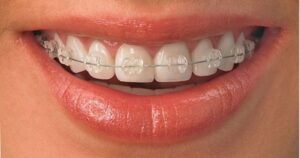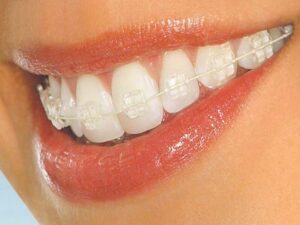
Dental braces are devices used to correct crowded or crooked teeth. Braces are most often used during adolescence, but more and more adults are getting corrective dental braces later in life due to more and more awareness and the technological advances. Conventionally braces are made of metal or ceramic, wires, and bonding material that attaches them to your teeth. An orthodontist is a doctor who specializes in this kind of device and treatment for misaligned teeth.
How braces move teeth?
Braces move your teeth by exerting constant pressure on them for extended periods of time. The shape of your jaw gradually adapts to conform to this pressure.
We tend to think of our teeth as being connected directly to our jawbone, making it hard to imagine how they can be moved. But underneath your gums is a membrane surrounded by your bones that roots your teeth to your jaw. This membrane controls the position of your teeth, and it responds to the pressure being put on your teeth by braces.
Getting braces doesn’t hurt during the appointment, and it takes between one to two hours for them to be installed. You may experience soreness for the first week you have braces as you adjust. Each time your braces are adjusted by your orthodontist, you may also be sore for a few days.
Types of braces
The type of braces that your orthodontist recommends will depend on several factors, such as your age and whether you have an overbite in addition to having crooked teeth. Braces are custom-made and individual to the needs of each person.
Classic braces that come to mind for most people are made of metal brackets that are glued individually to each of your teeth.
Other types of braces include:
- ceramic “clear” braces, which are less visible
- lingual braces, which are placed completely behind your teeth
- invisible braces, also called aligner trays, which can be taken off and placed back on throughout the day. Retainers are aligner trays you’re usually given after completing treatment with traditional braces. They’re used to keep your teeth in their new place.

Information about Self ligating Brackets
Self-ligating braces / SLB
Although Self Ligating brackets have been around for many years, they have only recently been in spotlight. self-ligating brackets are different type of dental braces, which generally utilizes force from permanently installed, movable component to en-leap the wire and to generate continuous, gentle forces for longer duration.
- Most significant difference between conventional dental braces and self-ligating braces is the absence of elastic bands or ties. They are typically smaller in size with rounded edges, hence they are friendly to the oral tissues
- patients with self-ligating brackets have better oral hygiene than patients with conventional brackets, since elastic ties are avoided.
- Treatment duration with self -ligating brackets is comparatively shortened with minimized and reduced chair time.
- Metal self ligating braces – These are metal Brackets with a shutter or lock system and do not require the use of elastic to tie the wire. In comparison to traditional metal braces, metal self-ligating braces are more comfortable and smaller in size. These are helpful in achieving arch expansion and minimize the need for extraction and are supposed to bring about faster results.
Information about Ceramic braces

Ceramic braces are similar to the metal braces, but they use clear or tooth-coloured brackets rather than grey or metallic brackets. They are the ones with clear or transparent looking brackets. They use tooth colour and blends more naturally with your teeth. The shape and size are the same as metal braces. These are less visible on the teeth and as a result, are preferred by older teenagers and adults who might have aesthetic concerns.

Here are some important points for those who are keen into ceramic brackets:
- These are manufactured with clear ceramic material and hence less visible therefore, these brackets can be opted by an older individuals or adult patients who are much concerned about aesthetics.
- As these are clear brackets an additional care needs to be taken in order to prevent the staining of the brackets
- Sometimes, even the wires used are of tooth colour which makes them less noticeable. Being less prominent, they require more care and protection compared to metal braces as they are larger and more brittle. They require extra protection, hence, are used more in upper teeth than lower.
- In terms of strength ceramic braces are usually strong, especially if they are high quality.
- Ceramic braces are cost effective because of high esthetic property and less visibility
Adults and braces
Adults are embracing orthodontia like never before. Adults getting braces today will find far more options than they remember — or had themselves — in their youth. For adults, aesthetics is the main consideration, Cost and “lifestyle” are the other key considerations. Each option offers advantages and disadvantages.
They include:
Amongst metal or ceramic switch out metal for clear or tooth-coloured ceramic. Treatment time is usually the shortest with conventional braces. But these devices are the most noticeable, as compared to other options available today.
Aligners are clear trays that are switched out every two weeks to accommodate the movement of teeth. They remain in the mouth for 20 to 22 hours per day, removed just long enough for meals and cleaning your teeth. The most common brand of aligners is Invisalign.
Aligners are less conspicuous, but they’re still not completely invisible. They don’t affect how you brush and floss your teeth (unlike other types of braces). However, aligners require the discipline to keep them in every possible moment and to switch out the trays on schedule. Shirking this responsibility sometimes means that treatment with aligners takes longer than with conventional options.
Lingual braces are virtually invisible and work just as quickly as conventional braces. However, they are custom-made and typically cost more than other options.
Regardless of the type of appliance, your orthodontist may want you to wear a retainer after treatment is complete. You might wear it part or all of the day.
FREQUENTLY ASKED QUESTIONS
In general, if you have healthy gums age is not a barrier and starting from age 7 anybody can get braces. however, if you’re pregnant or thinking of trying to get pregnant, you should talk with your OB-GYN about how braces could affect your pregnancy.
You may also want to speak with your primary doctor if you have underlying health issues that you’re concerned could be affected.
Treatment lengths vary for every person, but typically people wear braces for one to three years. By following the instructions of your orthodontist carefully, you can ensure that you’re wearing your braces for the shortest time span that is possible.
- hard candy
- popcorn
- chewing gum
